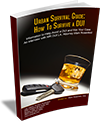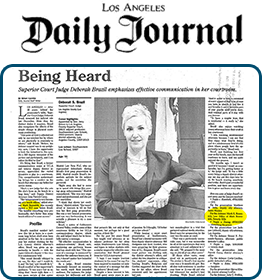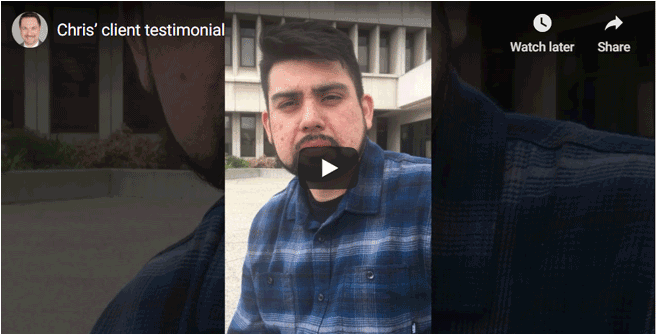By Mr. Rosenfeld:
Q: You have another notebook here, what is that notebook?
A: It’s not mine.
Q: Okay. The operational plan you brought with you talks about the concept of operation and in section three, it talks about west and east bound Pacific Coast Highway; is that correct?
A: Yes.
Q: That would be the same thing as talking about northbound and southbound Pacific Coast Highway?
A: Yes, westbound is north and eastbound is south.
Q: It’s because it’s not straight?
A: It goes in every direction eventually.
Q: Okay. Is there concept operations saying the location has been determined using the criteria found in departmental field operation 89-2…do you know what that is?
A: Basic check point planning that mirrors the requirements of O.T.S.
Q: Do you have that document in your office?
A: It’s available.
Q: And it does say that?
A: Yes.
Q: And it talks about if there is a backup what is supposed to be done?
A: Yes.
Q: In that section “in no case shall a vehicle be delayed for longer than three minutes”; correct?
A: Yes.
Q: So the operational plan is telling you that if cars are backed up for three minutes that you need to do something?
A: Correct.
Q: And you need to stop the backup from occurring?
A: Correct.
Q: The operational plan talks about alternative screening procedures?
A: Yes.
Q: And it says that the first alternative screening procedure is to screen eight vehicles and then let five vehicles pass through unscreened?
A: Yes.
Q: It talks about further alternative screening procedures that if it becomes impractical to do that, eight vehicles should be screen and eight vehicles should pass should pass through?
A: Yes.
Q: Other than reviewing the Crossroads program, did you take into consideration any other factors in choosing this location for a check point?
A: As I said, also, the logistics where there was sufficient space to screen vehicles, including officer safety and the vehicle safety where it can be done from a manner for officers and people that are driving.
Q: Are you familiar with S.W.I.T.R.S.?
A: Yes.
Q: What is that?
A: That’s the CHP compiles all the traffic data which we provide via Crossroads to analyze collision insurance accidents in the state.
Q: And did you review any S.W.I.T.R.S documentation in choosing location for a check point?
A: No.
Q: The operational plan discusses the time of the check point?
A: Yes.
Q: And the time of the check point and the operational plan is 7:30 P.M. to 3:30 A.M.?
A: Correct.
Q: Your deputies were out on PCH an hour and a half before that beginning to set up?
A: Yes.
Q: And put out cones?
A: Correct.
Q: Who selected the number of hours the check point would run?
A: I have to comply with the grant and what’s allotted; therefore, I determined the number of deputies to hire and the number of hours we could work.
Q: So were you responsible for choosing the hours for the check point?
A: Yes.
Q: When you took training with the office of traffic safety and the CHP, did they discuss how long a check point should run?
A: Yes.
Q: Did they say it should run four to six hours?
The Court: Sorry about that. Go ahead.
Mr. Rosenfeld: Thank you, Your Honor.
Q: When you conduct a check point, you keep documents of what happens at the check point?
A: Yes.
Q: And you keep track of any problems that were encountered during the check point?
A: Problems, I don’t understand. Did you recall any problems with this check point?
Q: That means keep track of the number of total of cars that go through the check point?
A: Yes.
Q: Did you do that?
A: Yes.
Q: Where is that document?
A: Deputy Curry probably had that.
Q: Can you tell us how many people were given field sobriety tests to determine whether or not they were driving under the influence?
A: That would also be on the summary page.
Q: Do you have any information that says your estimate of 15 to 20 people was arrested?
A: Yes.
Q: And, two, maybe two of those people were arrested for driving under the influence?
A: Yes.
Q: Other than Mr. Client, do you know who was arrested?
Mr. D.A.: Objection, relevance.
The Court: The question just asks does he know; it calls for a Yes or No.
The Witness: No.
By Mr. Rosenfeld:
Q: And with the people that were arrested that were not arrested for D.U.I.s, do you know what they were arrested for?
A: Not exactly, but generally, it’s for suspended license or no license in possession; it could also be for possibility of open container, but I don’t know the exact breakdown which Deputy Curry might have.
Q: You have some documents in front of you and I have not had the benefit of reviewing those in detail. I would like to mark those documents as defense exhibits and have you identify each one for the record. Your Honor, may I approach?
The Court: Why don’t we make copies of what’s there and do it that way instead of marking his.
Mr. Rosenfeld: Sure.
The Court: Why don’t you approach the witness for a moment; show me which documents that you want copied.
Mr. Rosenfeld: It appears that there are two stapled documents that I talked about before, two-page document, and I think it was a seven-page document. The other documents I believe have been provided to me already through the district attorney office.
The Court: All right. Why don’t you hand those back to the sergeant. Can I have those?
Mr. D.A.: Your Honor, for the record, the People haven’t received copies of those either and would request a copy at this point.
The Court: Make one for Rosenfeld if you would and one for him and one for the court file. One will be marked for exhibit. What I’m going to do while he’s doing that, I’m going to have this witness step down. Let me clear some 33 of those other cases.
Mr. Rosenfeld: Thank you, Your Honor.
The Court: Step down, do not leave the courtroom.
(BRIEF RECESS TAKEN.)
The Court: J. Client, case number 3vy06269. Mr. Rosenfeld is present, and Mr. D.A., and the sergeant is back on the witness stand. Do you recall you’re still under oath?
The Witness: Yes, Sir.
The Court: Saak made copies of the report that’s going to be marked. Mr. Rosenfeld, have you receive the copies that I requested my clerk to make?
Mr. Rosenfeld: Yes, your Honor, I did.
The Court: And I’m going to give these back to the sergeant and you can have them mark them, and you also have a copy.
Mr. D.A.: I do.
The Court: Go ahead.
By Mr. Rosenfeld:
Q: Morning, again, deputy. You now have copies of the documents that you brought in today, and I just want to talk about those documents you have in front of you. The larger packet, we can put on the lower right-hand corner?
The Court: What is the title of it that you’re going to have marked? What is the title of that document?
A: Collision report summary.
The Court: And you want that marked as defense exhibit.
Mr. Rosenfeld: Please. Defense “A.”
The Court: Okay.
The Court: Defense “A” for identification.
(Marked for identification, defense exhibits A.)
By Mr. Rosenfeld:
Q: And the stapled documents, the two-page document, what is that document?
A: Monthly traffic collision report.
The Court: Marked for identification defense B.
(Marked for identification, defense exhibits B.)
Mr. Rosenfeld: Thank you, your Honor.
Q: Deputy, what we’ve marked as defense “B”, did you prepare this document yourself.
A: No.
Q: I just had a brief opportunity to look at it, and if we look at D.U.I. collisions, it lists the number of D.U.I. collisions with fatalities as three, and the total of number D.U.I. deaths as three. Do you see what I’m referring to on the first page?
A: Yes. Those are the same thing, D.U.I. collisions, right?
Q: So what’s the difference between fatalities at and deaths?
A: Well, there really isn’t but it doesn’t constitute that. For instance, you can have one D.U.I. collision with three fatalities and three deaths, all in one collision.
Q: Can you tell in the D.U.I. collisions, how many of those incidents are duplicates?
A: Not with this document, no.
Q: And what’s been marked as exhibit A, that document, if I go through it, that’s going to contain the 26 driving under the influence related accidents that you talked about before?
A: Correct.
Q: And you cannot tell us how many of those 26 resulted from an arrest, correct?
A: Not from this document, no.
Q: Can you tell us just with your testimony how many of those 26 resulted in a D.U.I. arrest?
A: No.
Q: Can you tell us how many it was determined on what’s been marked as exhibit A, that the primary collision factor was driving under the influence on the 26 that we’ve been talking about?
A: All the collisions on this document are based on collisions where the P.C.F. probable collision factor was D.U.I.
Q: How was it determined what the collision factor was?
A: For each collision?
Q: Yes, for each collision on what’s been marked on exhibit A.
A: Based on the investigation of each collision, for example, in some there is actually an arrest that was made for a D.U.I.; in others, there may be an impaired driver, but we don’t arrest them.
The Court: So in other words, an officer went out to the location, prepared a collision report, that information is put in a collision report which is then transferred over to this exhibit?
The Witness: That’s correct.
By Mr. Rosenfeld:
Q: And you don’t know who the officers were, right?
A: What?
Q: You don’t know who the sheriff deputy who did the traffic investigations were for these cases?
A: No.
Q: And you don’t know what they relied upon to form the opinion that someone was driving under the influence?
A: No.
Q: Where we have a traffic collision with a fixed object with no injuries, you don’t know whether someone was arrested, right?
A: Correct.
Q: Did you review any other reports for other areas other than the Big Rock and Tuna Canyon corridor and the Carbon Canyon and Las Flores corridors?
A: Yes.
Q: What documents did you review?
A: Similar report to the collision summary here.
Q: Do you have that document?
A: No.
Q: Is it in your office?
A: It could be generated. This is actually provided by Deputy Curry.
Mr. Rosenfeld: No further questions. Thank you.
The Court: Nothing further, Mr. D.A.?
Mr. D.A.: Just briefly, your Honor.






 Personal Attention
Personal Attention Every criminal case is unique and no attorney can guarantee the outcome of a case. The information on this site is legal advertising and for general information only. Using this site, requesting books, information, consultations or communicating with Attorney Rosenfeld through its site does not form an attorney/client relationship.
Every criminal case is unique and no attorney can guarantee the outcome of a case. The information on this site is legal advertising and for general information only. Using this site, requesting books, information, consultations or communicating with Attorney Rosenfeld through its site does not form an attorney/client relationship.








